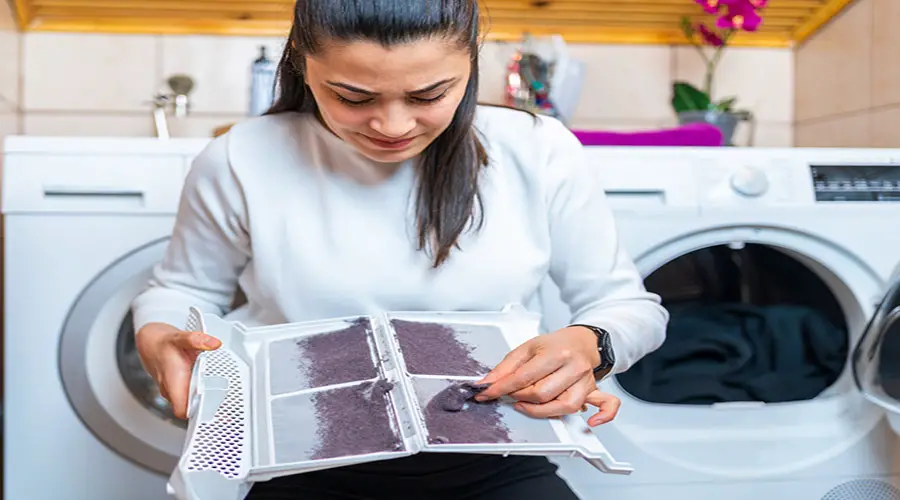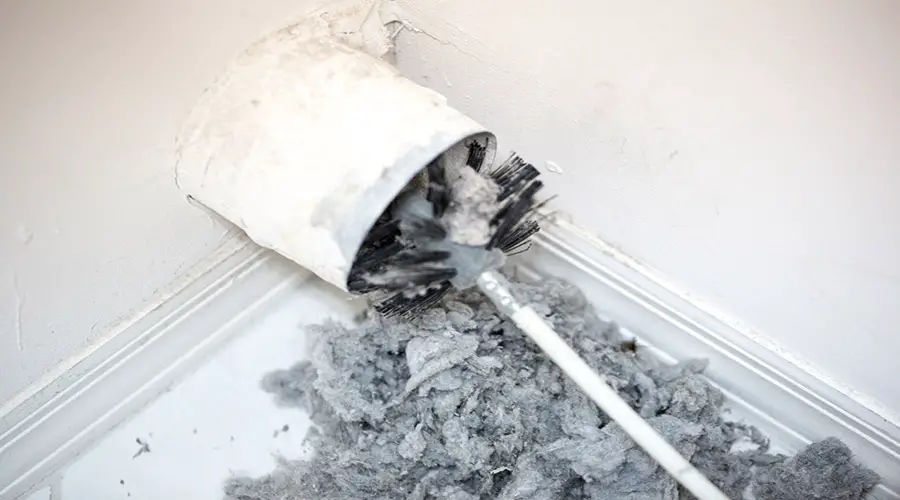
Dryers are a significant cause of house fires. Over a year, an estimated 26,000 house fires result from clogged dryers catching fire. It is also one of the least likely appliances that you would think needs regular maintenance.
The air coming out of a drying vent ranges from 125-135 degrees Fahrenheit. If the dryer is hot to the touch, this could indicate a fire hazard. There are multiple dryer types and numerous ways to deep clean your dryer. Finally, a dryer vent is supposed to be hot to the touch.
Read on to discover how hot the air is when it comes out of your dryer vent.
1. How Hot is the Air Coming Out of a Dryer Vent?
The air in the drum of a dryer has a temperature of 175 degrees Fahrenheit. Since moisture from the clothes that are drying will reduce the temperature, the temperature of the air coming out of the dryer vent ranges from 120 to 160 degrees Fahrenheit.
Read on to discover whether it is normal for a dryer vent to be hot.
2. Is it Normal for a Dryer Vent to be Hot?
The air coming out of a dryer vent is between 120 and 160 degrees Fahrenheit and can reach as high as 184 degrees Fahrenheit. The dryer’s fuses will blow if the air temperature reaches 185 degrees Fahrenheit, while the air temperature inside a gas dryer can range between 125 and 135 degrees Fahrenheit. In both cases, the dryer vent will be very hot because of the air coming out from it.
Read on to discover whether it is normal for a dryer vent to be hot to the touch.
3. Can a Dryer Vent be Hot to the Touch?
Since hot air is coming out of the dryer vent, it makes perfect sense for the vent to feel like it will burn you when you touch it. The surface temperature of a dryer vent can reach 130 degrees Fahrenheit and can burn your skin if you hold your hand in place.
While it is normal for a dryer vent to be hot to the touch, a clogged dryer vent can also overheat and become too hot. Dryer vents that are clogged can make the dryer a fire hazard.
Read on to discover why the dryer itself could get too hot.
4. Why Would a Dryer Get Too Hot?
First, it is common to see the heat inlet grille look charred and burned. This appearance can happen for a variety of reasons, such as:
- Discoloration from the colors of your clothing
- Normal wear and tear
- The heat generated by the dryer can discolor the vent
However, if you smell something burning, that could be a fire hazard and indicate that your dryer vents could be clogged, causing the machine to overheat as a result. Lint and dust in the dryer can accumulate over time, causing blockages that will prevent the dryer vent from regulating your dryer’s airflow.
Another sign that there is a potential fire hazard is if your dryer is burning your laundry. A fire hazard is especially possible if the dryer vent looks burned and you smell something burning coming from your dryer. If the dryer itself is hot to the touch, it is a sure sign that your dryer is overheating, and you should call a professional.
Read on to discover how you should deep clean your dryer.

5. How Should I Deep Clean My Dryer?
If you notice that your clothes are not dried all the way through or that they smell burned, you should deep clean your dryer before the situation gets dangerous. There are four main types of dryers: gas, top-loading, side-loading, ductless, and ventless. The processes for gas, top-loading and side-loading dryers are similar, while the cleaning processes for ductless and ventless dryers are similar.
The instructions below are how to clean the inside of each dryer:
Note: Clean the vent tubes every year. Vent tubes that are longer than 10 feet will need a cleaning every six months.
Gas Dryers:
- Turn off the gas supply
- Unplug the dryer
- Unscrew the filter panel
- Push in the clips and put the dryer cover up on its hinge
- Remove the modular connector
- Unscrew the screws on the side
- Lift the front panel off the clips
- Remove the belt from the tumbler
- Lift the tumbler and pull it out
- Using a paintbrush, clear the lint away from the motor and burner
- Vacuum the rest of the lint up
Top-Loading Dryers:
- Clean the lint trap
- Unplug the dryer
- Unscrew the duct from the smooth duct
- Inspect the vent for severe damage
- Remove the exterior vent port (if possible)
- Remove the lint in the external vent port
Side-Loading Dryers:
- Unscrew the four screws on the side of the lint trap that face into the dryer
- Push the left of the vent out and then up to remove
- Remove any remaining screws that in the vent piece
- Clean the back of the moisture sensor, but do not disconnect the wire
- Place it into the dryer, making sure to keep the wire connected
- Pull up on the inside lint trap
- Blow the gulley out with pressurized air
- Alternatively, use the crevice tool of your vacuum to get the lint up
Ductless Dryers:
- Unplug the dryer
- Pull out the bottom left
- Remove humidifier and air filter
- Clean the lint filter
- Vacuum the area where the access port was
- Clean the place where the air flows between the access port and lint screen
- Clean the cover to the access port
- Clean the inside of the door, paying attention to the seal
- Release the trap door where the sump pump is inside the access port
- Use a shop vac to get the water and debris out of the sump pump area
- Wash the lint screen and the other removable components with a hose
Ventless Dryers:
- Unplug the dryer
- Open the condenser compartment door
- Unlock the tabs, then remove the condenser
- Remove the condenser and filter
- Clean the condenser and filter with tap water, allowing the water to flow through the gaps
Read on to discover how to clean your dryer vent and hose.
6. How Do I Clean the Dryer Vent and Hose?
Deep cleaning the dryer machine is only one step of the deep cleaning process. The next step is to clean the dryer vent and hose. This process does not apply if you have a ventless or ductless dryer.
If you have a dryer with a vent and hose, the next step is to assemble the dryer vent cleaning kit and clean the dryer vent and hose. While quality will vary from one dryer vent cleaning kit to another, they all have the same process to set up and clean the vent:
- Assemble the wand and connect the hole to a shop vac
- Connect a drill to the drill adapter
- Make sure to put the wand down the vent before starting
- Turn the shop vac on
- Use the drill, so the wand is going in a clockwise direction
- Go slowly until the rod is at the end and will go no further
Add another rod segment, secure with duct tape, and keep going until the wand exits the external vent or can go no further. Repeat this process until you use all the rod pieces or the brush starts coming out of the exterior vent.
To remove the kit, use the drill in a forward motion, pull back, and pull out gently.
Do not use the drill in reverse, as this will cause the wand head to separate from the rod and wind up inside the vent or ductwork.
With the dryer vent cleaning kit already assembled, follow these steps to clean the flexible hose and the connection on the back of the dryer:
- Straighten it out as much as possible
- Use the dryer cleaning kit again, being gentle
- The shop vac can go directly into the flexible hose hole on the back
7. What are the Best Dryer Cleaning Kits on the Market?
As we mentioned, the quality of some dryer cleaning kits is superior to others. The most significant difference is the quality of materials and how well it works. We surveyed three of the most popular brands on the market:
Deflecto Dryer Duct Cleaning Kit
| Positives | Negatives |
|---|---|
| Easy to follow instructions | The head of the wand will separate if not duct-taped and accidentally drilling in reverse |
| Affordably Priced Under $20. Check Price on Amazon | |
| Effective |
Gardus LintEater Rotary Dryer Vent Cleaning System
| Positives | Negatives |
|---|---|
| Heavy-duty attachments | The kit can damage aluminum vents if you’re not careful |
| Rods are very flexible | Hard to take the drill adapter off |
| Unique blockage removal tool for removing debris | |
| You can use the bendable lint brush on the lint trap and the back of your dryer | |
| Vacuum attachment allows for easy lint removal | |
| Cleans from both outside in and inside out | |
| Check Price on Amazon |

Holikme 25 Feet Dryer Vent Cleaning Brush
| Positives | Negatives |
|---|---|
| Easy to use | It might not come with a drill adapter |
| Easy to assemble | Ineffective from the outside |
| Up to 30 feet in length. Longer models are available | No instruction manual |
| Check Price on Amazon | Hard to unscrew the kit when fit together – it requires two wrenches |
Final Thoughts
Dryers are a significant source of house fires. The fires often result when your clogged dryer is full of lint, dust, and other particles. If lint buildup in your dryer, vents, and flexible hoses are left unchecked, the dryer can overheat. This overheating will cause the dryer to catch on fire.
With a vigilant eye and the right equipment, you can ensure that your family will be safe before it is too late. Make sure to routinely deep clean your dryers about once or twice every year, and you will not have to worry about your house going up in flames.
If your dryer is burning your clothes, this can be a sign of a fire hazard. Blown dryer fuses, a burnt smell coming from inside your dryer, and a dryer that is hot to the touch can all be signs that your dryer vent is clogged and overheating.
In similar ways, you can deep clean the main types of dryers, including side-loaders, top-loaders, and gas dryers. Likewise, you can also remove lint from ventless and ductless dryers in similar ways. The process is mostly the same for all of them: take the dryer and its components apart, clean them, and reinstall them.
However, side-loaders, top-loaders, and gas dryers all must have their vents and flexible tubing cleaned. This cleaning process is where the dryer vent cleaning kits come in. The wand and its rods will clear the dryer vent, flexible hosing, and connection holes with ease through rotating action. While they all function similarly, the difference is the quality of the included parts.
Finally, dryers are an essential part of your household. Dryers keep your clothes clean and fresh. With routine maintenance and annual deep cleaning of the vents and flexible hoses, not only will you avoid your house catching fire, but your dryer will perform better and use less electricity. Your family and your wallet will thank you.
Sources







